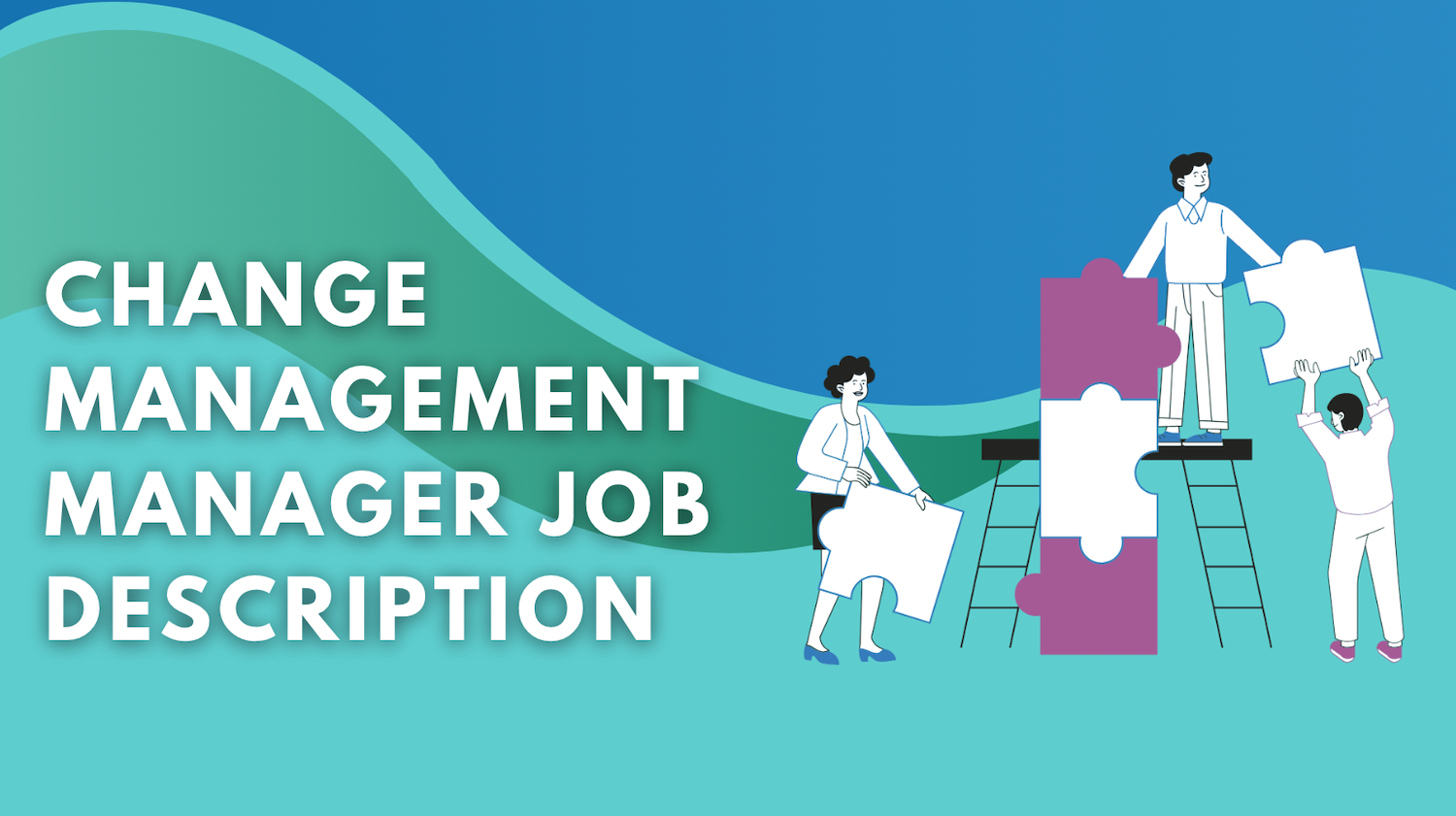What are the Real Roles & Responsibilities of a Change Manager? What Does a Change Manager Really Do?

Unlock Your Potential: The Ultimate Guide to Landing Your Dream Change Management Manager Job!
Have you ever wondered what it takes to be the maestro behind successful organizational transformations? If you’ve got the passion for steering change, inspiring teams, and turning challenges into triumphs, you’re in for a treat! Welcome to our ultimate guide on bagging the coolest role in town – the Change Management Manager.
In this guide, we’ll walk you through not just the typical change manager job description, we’ll spill the tea on what really makes a change management manager shine and dive into what really is a change managers role.
Think of it as your backstage pass to the world of change, where you’ll discover the perfect blend of skills, qualities, and that special touch of magic needed to become the go-to Change Maestro.
So, grab your virtual toolkit, put on your superhero cape (because, let’s face it, that’s what Change Managers are), and get ready to explore the exciting realm of change management like never before. Whether you’re a seasoned pro looking to up your game or someone itching to dive into this dynamic field, we’ve got nuggets of wisdom for everyone.
Let’s embark on this journey together and transform not just organizations but also your career aspirations. Get ready to shine as the Change Management Manager you were born to be!
Thrilled about the journey that lies ahead? Well we’ve got you covered with our concise overview. Brace yourself to delve into the nuances of the change manager job description, knowing that we’re right by your side for this illuminating adventure.
Quick Summary
Essential Tasks: Unmasking the Five Key Responsibilities of Managers
The five key responsibilities of a change manager, particularly in the context of change management, can be summarized as follows:
- Planning: Managers are responsible for strategic planning, aligning projects with company goals, and providing a vision for change. Change managers, in particular, must understand the big picture and plan the detailed implementation of change.
- Organizing: Once a plan is established, managers organize resources, people, timelines, and communication methods. In change management, the change manager structures the change management team and implements tools to keep the project organized.
- Staffing/Delegating: Managers build and lead a team by selecting the right individuals, delegating tasks, and fostering talent development. In change management, a change manager plays a crucial role in assigning change management roles within the team.
- Guiding: Managers guide project stakeholders by providing direction and motivation. Effective interpersonal skills are essential for creating a collaborative team environment. In change management, guiding involves managing resistance and ensuring team members feel part of the change process.
- Controlling Outcome: Managers are accountable for ensuring successful project outcomes. This involves follow-ups, reviewing metrics and key performance indicators (KPIs), and making prompt decisions when a project faces challenges. In change management, a change manager monitors milestones, employee training, and collaborates with leadership to secure a successful outcome.

Mastering Change: A Guide to Change Manager Roles and Responsibilities
Change management roles and responsibilities involve the key areas that need attention within a change management project, often reflected in the change management team structure. The change manager’s duties are distributed among various roles within the team, which can vary in size and complexity based on the project’s scale. Common change management roles include:
- Change Management Lead/Change Manager: Manages the entire project, ensures it stays on track, troubleshoots issues, and ensures desired results.
- Change Project Manager: Plans the project roadmap and ensures coordination among different elements.
- Change Communications Manager: Plans and deploys communication strategies to leaders, employees, and stakeholders through various channels.
- Change Training & User Support: Ensures employees are trained on new processes or software to implement the change successfully.
- Change Management Analyst: Tracks metrics to assess the project’s risk/benefit, monitor timelines, budget adherence, and overall mission alignment.
- Leaders & Change Agents/Champions: Internal leaders and change agents support the change initiative, providing crucial backing from within the organization.
Change manager responsibilities include:
- Apply a Structure to the Change Planning: Applies change management best practices or specific methodologies to provide a framework for the change management process.
- Assess the Change Impact: Conducts a change impact assessment to understand how the change will affect various areas of the organization.
- Gauge Organizational Change Readiness: Conducts a readiness assessment to provide details for creating a comprehensive change management plan.
- Create a Change Management Plan: Develops an action plan for the various change management roles to follow.
- Identify & Manage Stakeholders: Identifies and manages stakeholders, including employees, customers, and vendors, who will be impacted by the change.
- Mitigate Change Resistance: Proactively and reactively addresses and mitigates resistance to change, a natural part of the change process.
- Coach Leaders & Change Champions: Coaches organizational leaders on their roles in facilitating change and nurtures a change champions network.
- Communication Strategy: Crafts and implements an effective change communication strategy.
- Employee Training: Develops and implements an employee training schedule, assessing stakeholders’ progress in acquiring proficiency in new skills.
Nurturing Change Leaders: Qualifications Explored
Change Management Qualifications are essential for individuals aspiring to become change management specialists, and these qualifications vary based on the role’s seniority and associated responsibilities. The qualifications encompass education, experience, and training/certification requirements:
Change Management Qualifications for Education:
- A bachelor’s degree in business, communications, psychology, or a related field is often a requirement for most change management roles.
- Senior positions may necessitate a master’s degree.
- Some positions may consider comparable military training as an acceptable qualification.
Change Management Qualifications for Experience:
- Experience requirements align with the level of the change management role.
- Entry-level roles typically seek 3-5 years of change management experience.
- Mid-level roles often require 5-10 years of experience.
- Senior-level roles generally expect 10+ years of experience.
- Some positions may also accept project management experience.
Change Management Qualifications for Training/Certification:
- Employers may request formal change management training or certification for roles leading change initiatives.
- Candidates can choose training in general change management best practices or specific change methodologies.
- Change management roles may be expected to be familiar with one or more change models.
- Certification can be in a specific change methodology or in change management best practices that are not methodology-specific.
Detailed Deep Dive
You may have heard of a change management team at your organization or even been interested in a job as a change management specialist, but still be left wondering, “What does a change manager do anyhow?”
Change is such a general term that it doesn’t offer much of a description of change management roles and responsibilities.
Change managers and a change management team help guide organizations through transitions. Theses “changes” can be anything from reorganization due to a merger to transitioning an organization to a new VoIP phone system.
Any time there is a need to change the way something is done, a technology that is used, or how job duties are assigned, it involves an organizational change.
Ensuring that change goes smoothly and successfully is the ultimate mission of a change manager.

What Does a Change Manager Do to Facilitate Change?
But how you get from point A to point Z in an organizational change project involves multiple steps. Those steps all fall under the change management specialist and change management team.
Leading change management isn’t a piece of cake, because you’re dealing with habits that have been ingrained for years and have to convince everyone that the new way is going to be better.
But those who are trained in change manager responsibilities know how to take each step through a change project, one at a time, to keep everything on track and guide the project to successful completion.
What You’ll Learn in this Guide
In this OCM Solution article, we’ll answer the question, “What does a change manager do during a change project?” You’ll learn the various roles, responsibilities, and qualifications a change management specialist needs to have.
By the end, you should have a pretty good idea about what leading change management entails and what qualities good change managers possess.
See Also: Organizational Change Management Tasks & Checklist for Change Managers | (Step-by-Step)
Do you have questions on a change management duties or a change managers role? We’d love to hear from you, click here to contact us.
Overview | What Does a Change Manager Do?
In any type of organizational transition, there are both processes and people that have to be guided through a change.
For example, say that a company was changing from landline phones to a VoIP phone system. The processes that need to be changed are the equipment and systems used to handle phone calls, including any software, like a CRM, that calls might have been entered into.
On the people side, employees need to understand why the company is changing, what this means to them and how they do their job, and how they are going to learn the new system.
Change management qualifications include the ability to handle all those moving parts with the processes and the people impacted by an organizational change.
A change management team structure incorporates people that can handle different areas of a change management project, such as communications planning or leadership coaching. A full strategy that gives everyone a roadmap to follow also has to be developed.
We’ll get into the detailed change management roles and responsibilities shortly. Here is a brief overview of the main change manager responsibilities:
- Assessing risk for proposed changes
- Preplanning for a change project, including stakeholder analysis, project assessment, etc.
- Coordinating the change management team, leaders, and stakeholders
- Implementing the change management project
- Problem-solving as issues and resistance arises
- Monitoring change management metrics to ensure things stay on track
- Following up after “go-live” to provide support and reinforce the change
Change managers are ultimately managers, so before we dig into the details of change management roles and responsibilities, it’s helpful to answer the question, “What are the five key responsibilities of a manager?”
Don’t Miss: Hiring a Project Manager? Requirements & Interview Questions to Ask
Got questions like “What is a change manager job description?” or “What are the change manager roles and responsibilities?”. Drop us a message and let us know.
What are the Five Key Responsibilities of a Manager?
Managers of any type have five core responsibilities that guide what they do. In the case of change management qualifications, it will pertain to how change managers direct organizational change and lead those in the change management team structure, leaders, and other stakeholders.
When you understand, “What are the five key responsibilities of a manager?”, the responsibilities that are specific to leading change management will make more sense because you’ll have a general understanding of the manager framework.
1. Planning
Managers are the ones that take on the strategic planning process for a project. This involves evaluating the goals of the company and ensuring a project is designed to meet or exceed them.
What does a change manager do when it comes to planning? They need to both be able to see the big picture so they can present a strategic vision about the change to an organization and be able to plan on a detailed level for each part of the change implementation.
2. Organizing
Once a plan is put into place, the manager then organizes all the resources and people needed to carry it out. They look at things like timelines, milestones, methods of communication, and resource allocation that will be needed.
The change management team structure is set up by a change manager so it can be ready to fill with the right people. A change management specialist will often put change management tools into place that can help keep the project organized.
3. Staffing/Delegating
Managers need to have a team to help them get a project done, which includes delegating tasks to the best people. Staffing consists not only of choosing the right people for the right job, but also mentoring and developing talent.
Change management roles within the team will be filled by the change manager. When asking, “What does a change manager do?” it’s important to realize that they can’t do everything themselves, they need a team to help drive a change project to completion.
4. Guiding
Managers will guide project stakeholders, giving them important direction and motivation to see a project through to success. This involves having good interpersonal skills so people will feel as if they’re part of a team and WANT to do something, rather than just feeling they have to.
Change management qualifications are particularly important in the area of guiding. Because they’re leading people through a change, a change management specialist has to expertly manage feelings of resistance that are natural anytime someone is asked to change a process or way of doing things in a new way.
5. Controlling Outcome
There is a lot of responsibility in being a manager. Besides planning and implementing a project, they have to keep on top of things to ensure a successful outcome. This can involve follow-ups with team members, reviewing project metrics and KPIs, and making fast decisions when a project is going “off the rails.”
When leading change management, a change manager will keep track of change project milestones, employee training progress, and also check in with leadership and the change champions network to help ensure a successful outcome.
Related: Best Keywords/Skills for a Project Manager Resume
Are you looking answers to questions like “What is a change management job description?” or “What does change manager do on a daily basis?”. Send us a message with your questions or comments.
Change Management Roles and Responsibilities
Change management roles can be described as the key areas within a change management project that need to be addressed. These roles will often be reflected as the change management team structure.
The change manager’s responsibilities will be delegated among the different roles of the change management team.
Some change management team structures will be very detailed and include multiple change management roles, for example, in the case of a large multi-national organization with multiple offices going through the same change project.
Other change management teams will be more compact, only needing a handful of people for successfully leading change management for a single location.
We’ll start with the change management roles, then discuss the change manager responsibilities.
Change Management Roles & Change Management Team Structure
The exact change management roles used for a change management team structure will vary by size, as mentioned above. Here are some of the common roles that will be assigned according to a project’s change management qualifications and requirements.
- Change Management Lead/Change Manager: The change manager is also sometimes called the change management lead. They’re typically the person that is managing the entire project and delegating tasks to others. They’ll be the one that needs to ensure a change project is on track, manage any troubleshooting, and make sure a project brings the desired results.
- Change Project Manager: This is one of the change management roles that can morph into multiple responsibilities. They’ll usually take point on planning the project roadmap and helping check-in with everyone to ensure all moving parts are going along in sync.
- Change Communications Manager: Communications are a big part of a successful change project. The communications manager will plan out the different forms of communication to leaders, employees, and other stakeholders and deploy the communication plan via multiple channels.
- Change Training & User Support: Organizational change often involves employees needing to train on new software or process. This is among one of the most important change management roles because the training & user support role ensures everyone has the skills and proficiency needed to successfully implement the change.
- Change Management Analyst: Multiple metrics can be tracked to both measure a change project for risk/benefit and monitor a project to ensure it stays on timeline, budget, and mission. Working with this type of information is what the change management analyst does.
- Leaders & Change Agents/Champions: The change management roles that come from within an organization are the leaders and change agents that are coached to help drive and support a change. It’s important that a change management specialist gets support from within an organization to help them implement and champion a change initiative.

What Does a Change Manager Do?
Change Manager Responsibilities
Now that we’ve discussed the change management roles, we will be sharing the workload of a change management project and go over the various change manager responsibilities that are shared among the team.
Ultimately, the change management roles and responsibilities fall under the leadership of the change manager.
- Apply a Structure to the Change Planning: Change managers are responsible for applying change management best practices or a specific change model/methodology to provide a framework for the change management process.
- Assess the Change Impact: In order for various change management roles to properly train and prepare stakeholders for a change, it’s important to know the impacts of a change to various areas of an organization. This is done through a change impact assessment.
- Gauge Organizational Change Readiness: The readiness assessment is another important preplanning responsibility of the change management specialist. It gives the needed details for creating a change management plan.
- Create a Change Management Plan: The change management plan gives the various change management roles an action plan that they can follow.
- Identify & Manage Stakeholders: Stakeholders include anyone that is going to be impacted by a change. These can be employees, customers, vendors, and others. Identifying and managing stakeholders is one of the key change manager responsibilities.
- Mitigate Change Resistance: Change resistance is a natural part of the change process. It’s a big part of change management roles and responsibilities to both proactively and reactively address and mitigate resistance to change.
- Coach Leaders & Change Champions: One of the change manager’s responsibilities is to coach leaders in an organization on their roles in facilitating change in their departments. A change champions network also should be put together and nurtured.
- Communication Strategy: One of the important change management qualifications for a change leader is the ability to craft and implement an effective change communication strategy.
- Employee Training: An employee training schedule needs to be created and implemented, and stakeholders need to be assessed for their progress in becoming proficient in the new skills.
Popular Article: Business Change Manager | All You Need to Know | Roles, Jobs, Training
Are you looking for more information on questions like: “What makes up a business change manager job description?” or “What are examples of a change manager position description?”. Send a message to our change management team.
Change Management Qualifications
Anyone that is interested in becoming a change management specialist will find there are certain change management qualifications that employers are looking for.
The qualifications will vary according to the seniority of the change management role and duties and responsibilities requested.
Change management qualifications will include educational requirements, experience requirements, and change management training/certification requirements. We’ll look at each area below.
Change Management Qualifications for Education
You’ll find that most change management roles require at least a bachelor’s degree in a business discipline, communications, psychology, or a related area.
Some of the more senior change management specialist positions require a master’s degree.
We’ve also found that some positions will accept comparable military training.
Change Management Qualifications for Experience
The experience requirements closely match the level of the change management roles being filled. We’ve found a range that is typically between 3-10 years of change management experience being required. Some job listings will also accept project management experience.
Here are the typical qualifications per change management roles and responsibilities levels:
- 3-5 years of experience: Entry Level Change Management Roles
- 5-10 years of experience: Mid-Level Change Management Roles
- 10+ years of experience: Senior Level Change Management Roles
Change Management Qualifications for Training/Certification
Some employers hiring for positions leading change management will request formal change management training or certification.
Candidates can choose to train on general change management best practices or on specific change methodologies. There are several different change models that can be used to structure a change process; often, change management roles are asked to know one or more of them.
Beyond change training, is obtaining a certification in change management. This can also be approached in two ways:
- Certification in a specific change methodology
- Certification in change management best practices (not methodology specific)
Here are links to more information on change management training and the top change management certifications.
Are you looking for more information on the difference between a simple ocm job description and a ocm lead job description? Send a message to our change management team.
What Makes a Good Change Manager?
Beyond change management roles and responsibilities and qualifications, there are some intrinsic qualities that make someone a good change manager. These are both natural personality traits and things that can be learned as part of change management roles.
If you’re asking, “What does a change manager do?” these traits will often come up as desirable qualities of a change management specialist.
Qualities that make a good change manager include:
- Being a good communicator, written and verbal
- Excellent people skills
- Being able to actively listen
- Ability to understand what people experience when going through change
- Excellent problem-solving skills
- Having an “easy-to-work-with” personality
- Being able to effectively work with people in all levels of an organization
- Ability to work both independently and with a team
- Ability to lead others towards a common goal
- Understanding of how to positively motivate people
- Flexible and adaptable to changing situations
- Detail-oriented
- Ability to delegate
Read More: Change Management Project Manager | All You Need to Know | Pay Rates & More
Conclusion: What Does a Change Manager Do When Leading Change?
A change manager has multiple responsibilities when it comes to leading change management projects. One of these is delegating to other change management roles and then keeping a change project organized and on track.
You can find many change management qualifications by looking at the key responsibilities of a manager. Change management specialists are leaders and managers, first and foremost.
Their expertise among other managers is in helping organizations evaluate, plan, implement, and sustain an organizational change.
While change management roles and responsibilities can sometimes seem endless, with training and the use of change management best practices, change managers keep all moving parts working in unison to help organizations transform and implement change successfully.
Note: Content on OCM Solution's ocmsolution.com website is protected by copyright. Should you have any questions or comments regarding this OCM Solution page, please reach out to Ogbe Airiodion (Change Management Lead) or the OCM Solutions Team today. OCM Solution was previously known as Airiodion Global Services (AGS).
Images: https://stock.adobe.com, Microsoft 365 Clip Art Image(s) (Bing images licensed under the Creative Commons license system.)







